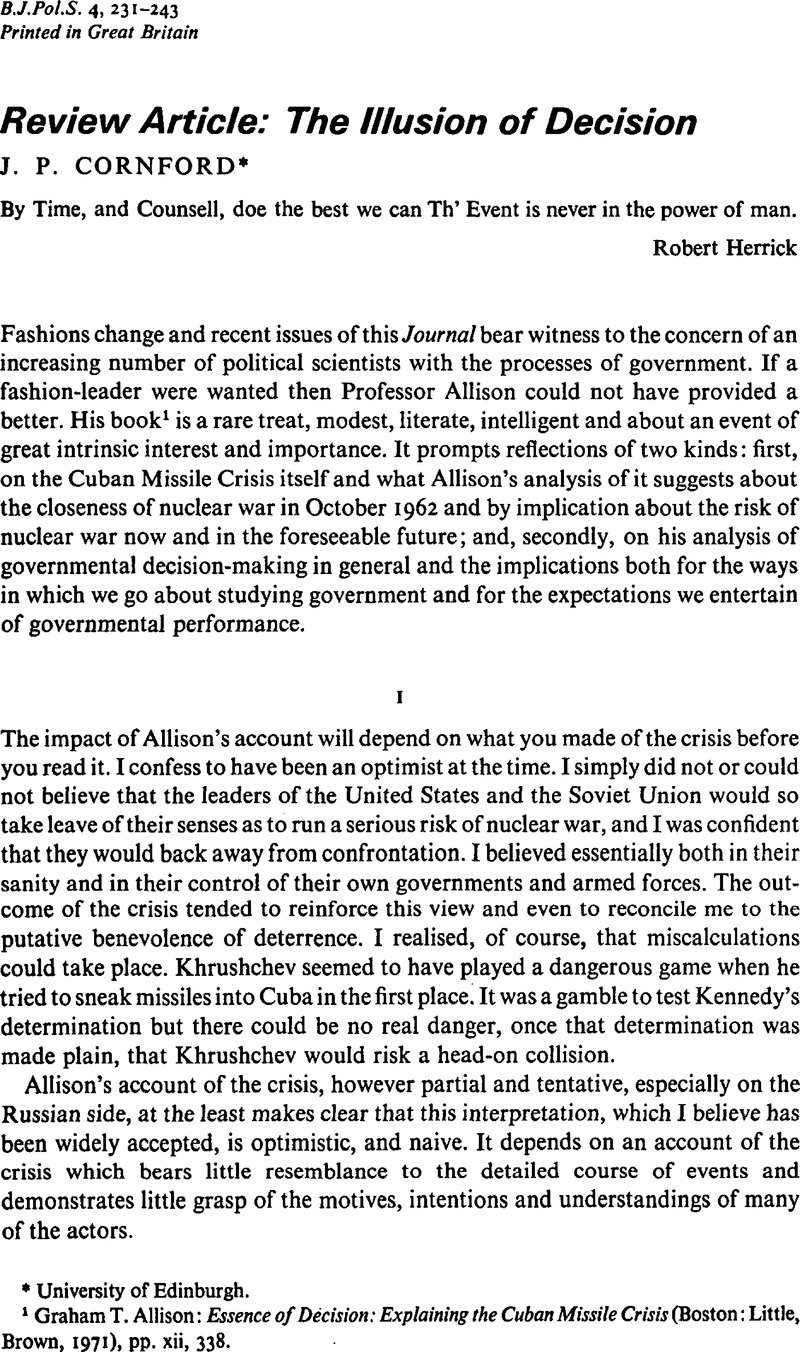Article contents
Review Article: the Illusion of Decision
Published online by Cambridge University Press: 27 January 2009
Abstract

- Type
- Review Article
- Information
- Copyright
- Copyright © Cambridge University Press 1974
References
1 Allison, Graham T.: Essence of Decision: Explaining the Cuban Missile Crisis (Boston: Little, Brown, 1971), pp. xii, 338.Google Scholar
2 Seidman, Notably Harold, Politics, Position and Power: The Dynamics of Federal Organisation (Oxford: Oxford University Press, 1970).Google Scholar
3 Those who like their philosophy homespun and hairy-chested will find a vivid exposition of this view in Mailer's, NormanThe Armies of the Night (New York: New American Library, 1968).Google Scholar
4 Cf. Wildavsky's observation: ‘some officials do not deal with complexity at all; they are just overwhelmed and never quite recover’. Wildavsky, A., The Politics of the Budgetary Process (Boston: Little, Brown, 1964), p. 11.Google Scholar
5 E.g. ‘The lesson to be drawn from any study of high politics is that the central concern of practitioners is with their position relative to one another.’ Jones, Andrew, ‘Liberal History’ Parliamentary Affairs, XXV (1972), 351–4.Google ScholarJones, has given an excellent example of history from this perspective in The Politics of Reform, 1884 (Cambridge: Cambridge University Press, 1972).Google Scholar This is a market theory of influence which has been given its most cogent exposition in Banfield's, E. C.Political Influence (Glencoe, III.: Free Press, 1961).Google Scholar
6 These distinctions are made by Webb, Adrian, ‘Planning Enquiries and Amenity Policy’, Policy and Politics, I (1972), 64–74, p. 71, note 12.Google Scholar
7 This criticism has been made by Self, Peter, Administrative Theories and Politics (London: Allen and Unwin, 1972), pp. 40–1Google Scholar, and Rose, Richard, ‘Comparing Policy’, European Journal of Political Research, I (1973), 67–93, p. 86CrossRefGoogle Scholar, among others.
8 ‘The atomic hypothesis which has worked so splendidly in Physics breaks down in Psychics. We are faced at every turn with the problems of Organic Unity, of Discreteness, of Discontinuity - the whole is not equal to the sum of its parts, comparisons of quantity fail us, small changes produce large effects, the assumptions of a uniform and homogeneous continuum are not satisfied. Thus the results of Mathematical Psychics turn out to be derivative, not fundamental, indexes not measurements, first approximations at best; and fallible indexes, dubious approximations at that, with much doubt added as to what if anything, they are indexes or approximations of.’ Keynes, J. M., Essays in Biography, ed. Keynes, Geoffrey (London: Heinemann, 1961), pp. 232–3Google Scholar; cf. alsoHeilbroner, Robert L., ‘Is Economic Theory Possible?’ in Between Capitalism and Socialism (New York: Vintage Books, 1970), pp. 165–92.Google Scholar
9 Cf. Williams, Alan, ‘Cost-benefit Analysis: bastard science and/or insidious poison in the body politick’, Journal of Public Economics, I (1972), 199–225CrossRefGoogle Scholar; Wildavsky, A., ‘The Political Economy of Efficiency: Cost-Benefit Analysis, Systems Analysis and Program Budgeting’, Public Administration Review, XXVI (1966), 292–310CrossRefGoogle Scholar; and Dennis, Norman, Public Participation and Planner's Blight (London: Faber, 1972).Google Scholar
10 E. C. Zeeman, unpublished paper on catastrophe theory given at a seminar on ‘The Use of Models in the Social Sciences’, University of Edinburgh, 1972.
11 Wildavsky, , Politics of the Budgetary Process, p. 44.Google Scholar
12 Wildavsky, , Politics of the Budgetary Process, p. 72.Google Scholar
13 This would involve both the double standard and the double audience problem. First, how do men accept in public life acts and arguments they would scorn in their private affairs ('the necessary murder'). And second, the nuclear deterrent can only be justified to oneself on the grounds that one will never use it, but it only makes sense at all if one's opponent believes that one might. If he comes to believe one's moral justification — that one will never use it — one must either abandon the deterrent or the justification.
14 Keeling, Desmond, Management in Government (London: Allen & Unwin for the RIPA, 1972)Google Scholar is particularly good on the contrasts between public and private bureaucracies. For a good account of the second order effects of new budgetary techniques in British government see Greenwood, David, Budgeting for Defence (London: RUSI, 1972).Google Scholar First hand accounts of the operations of PESC suggest that it has much more significance as a means of maintaining Treasury control over levels of spending than as a means of resolving problems of priority within the public expenditure programme. The complexity of rational improvement is beautifully illustrated in Friend, J. K. and Jessop's, W. N. excellent Local Government and Strategic Choice (London: Tavistock Publications, 1969).Google Scholar
15 The similarities and limitations of Allison's models are readily apparent if one compares them to what may more reasonably be called an alternative paradigm, say Chinese theory and practice as described by Schurmann, Franz in Ideology and Organization in Communist China (Berkeley and Los Angeles: University of California Press, 1966).Google Scholar
16 Cf. for instance Clarke's, M. G. review of ‘The Dilemma of Accountability in Modern Government’ in Political Studies, XIX (1971), 469–72.Google Scholar
- 12
- Cited by




